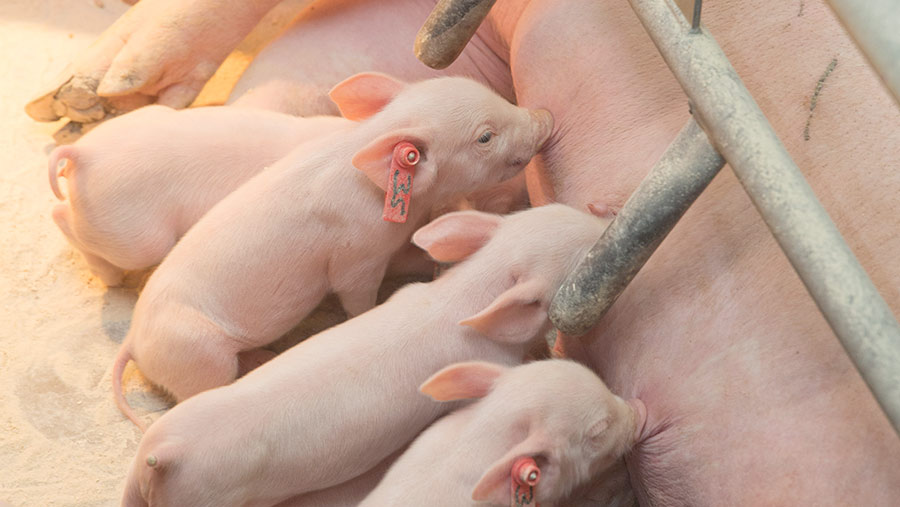Farrowing management advice for stockpeople
 © Tim Scrivener
© Tim Scrivener Piglet survival and sow health are likely to be compromised if a sound system is not in place during farrowing.
Therefore, stockpeople need to ensure that attention to detail is enforced before, during and after farrowing.
Farmers Weekly spoke to Richard Bows, knowledge exchange manager at AHDB Pork, about some of the key areas to focus on in the farrowing house.
See also: Farm’s farrowing tent brings welfare benefits to pigs
Pre-farrowing
What do I need to do to prepare the farrowing house?
Before introducing a batch of sows and gilts into the farrowing house, a thorough clean is required to minimise the risk and possible spread of infection.
Following the steps below will help stockpeople ensure the unit is fully prepared for the start of farrowing
- Remove all organic matter from the previous batch of sows and gilts.
- Use a detergent to break down any built-up areas that are difficult to remove.
- Next, pressure wash the entire unit using a fit-for-purpose disinfectant – checking label recommendations to ensure correct levels are being used.
- Allow the house to dry entirely before bringing in the new batch.
- Check for damage and carry out any repairs as necessary – are the drinkers all working at the correct flow rate? Are fans and ventilation equipment functioning properly?
- Once the house is completely dry, heat the room so that stock are not coming into a cold house.
- At three to five days before the predicted farrowing date, bring animals into the clean, disinfected unit to ensure they are settled in case of early labour.
At farrowing
What is the best way to settle gilts?
When introducing gilts into the farrowing house, it is important to keep potential stress to a minimum. Allow extra time to get them into the pen and keep an eye on food intake and any signs of health deterioration.
Ensure plenty of nesting materials are available. Chopped newspaper works particularly well, as this will allow gilts to exhibit natural behaviour which will have a calming effect and reduce stress levels.
When should I intervene with the farrowing process?
When farrowing is imminent, the signs are fairly straightforward – reduced appetite, chewing on bedding and failure to settle are all obvious signals. However, knowing when to intervene may not be so apparent.
On average, piglets are born 40-45 minutes apart, so using a farrowing disk to record the intervals between births can help to monitor whether there is a problem or not.
If the gaps between birthing get larger, or nothing seems to be happening despite contractions from the sow, it may be time to intervene.
If you are unsure of what the potential problem may be, do not be afraid to call a vet.
Post-farrowing
What do I need to consider in terms of diet for both the sow and her piglets?
Most producers will feed a specific farrowing or lactating diet which will be specially formulated by both the farmer and nutritionist to ensure it meets the demands of the sow.
It is important at this stage to ensure the sow doesn’t stall in terms of feed intake – by under- or over-eating.
To avoid this, a feed chart is a useful way to increase feed intake in a structured way, as well as to assess daily whether sows are eating well and looking healthy.
Look out for the following signs which could highlight a problem with either the ration itself or the health of the sow:
- Not visually seen eating
- Lying down for long periods or struggling to get up
- Lethargy
- Signs of physical injury.
As with all livestock, colostrum management is key for newborn piglets – particularly in the first six to 12 hours.
For big litters (anything over 14 piglets) split suckling is recommended. ADHB Pork has a handy guide. Use a box to separate the larger, stronger piglets from the others to give the smaller, weaker piglets a better opportunity to feed.
What effect will environmental conditions have on the productivity of sow and piglets?
Controlling the environment of the farrowing house is just as important as diet for both sows and piglets.
Temperature control is key and stockmen should ensure the house is at an ambient temperature of 22C to 24C at the time of farrowing, with additional heat at the back of pens if needed.
Over the seven to 10 days post-farrowing, this temperature should gradually be brought down to about 18C-19C depending on the type of heating system.
However, it is important to consider the following two types of behaviour of the piglets before deciding on temperature control:
- Piglets huddled together at one end of the crate. This means it is likely that the temperature is too low and they are not being provided with sufficient heat.
- Piglets spread out across the pen, away from the heated end. This means that the temperature in the house is too high and you should consider lowering it.
Remember – you are trying to create two environments under the same roof (one for the sow and one for the piglets) and the requirements are slightly different.
Farrowed sows need temperatures of about 16C and piglets require 18C upwards. Monitor this regularly and tweak as necessary to ensure they are all warm and comfortable.
Top tips for piglet survival
Piglet survival – leading to a litter of healthy, weaned piglets – is one of the key factors in determining the success and ultimately the profitability of pig unit.
While a number of factors contribute to piglet survival, farmers should look to focus particularly on the following three areas to ensure mortality is kept to a minimum.
1. Ensure a good quality and quantity of colostrum is received
2. Think strategically about fostering piglets – don’t over-foster
3. Look after the sow and she will take care of the piglets.
